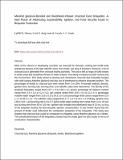| dc.contributor.author | Gesase, Lynder | |
| dc.contributor.author | King’ondu, Cecil | |
| dc.contributor.author | Jande, Yusufu | |
| dc.date.accessioned | 2020-03-09T07:04:33Z | |
| dc.date.available | 2020-03-09T07:04:33Z | |
| dc.date.issued | 2019-11-22 | |
| dc.identifier.uri | https://doi.org/10.1007/s12155-019-10076-9 | |
| dc.identifier.uri | http://dspace.nm-aist.ac.tz/handle/123456789/615 | |
| dc.description | This research article published by Springer Nature Switzerland AG., 2019 | en_US |
| dc.description.abstract | Most of the citizens in developing countries use charcoal for domestic cooking and small-scale enterprises because of its high calorific value, less smoke, and easy to transport. However, a lot of charcoal dust is generated from charcoal trading activities. The dust is left as heaps of solid wastes in urban areas and sometimes thrown in water streams, thus being a nuisance to both humans and the environment. This study aimed to develop and characterize charcoal dust briquettes bonded with wild cassava Manihot glaziovii and also use of bioethanol to enhance briquette ignition. The percentages of binder to charcoal dust were varied from 5 to 30%. Proximate analysis, density, ignition time, burning rate, burning time, and calorific value were determined. The density of the produced briquettes ranged from 0.67 ± 0 to 0.83 ± 0.1 g/cm3; percentage of moisture content varied from 3.4 ± 0.2 to 4.2 ± 0.2; ash content varied from 19.6 ± 0.6 to 21.5 ± 0; percentage volatile matter ranged from 19.8 ± 0.3 to 24.3 ± 0.4; and percentage fixed carbon ranged from 51.9 ± 1.1 to 55.3 ± 0.2. The calorific value ranged from 17.7 ± 0.7 to 19.7 ± 0.3 MJ/kg, ignition time 139 to 163 s, and burning rate 0.3 to 0.7 g/min while water boiling time varied from 14 to 19 min and burning time from 85 to 116 min. Ignition test revealed that bioethanol ratio of 15 mL to 56 g of the briquette showed the best briquette ignition characteristics. It was further found that the amount of binder used influenced the combustion properties of the briquettes. This study also showed that charcoal dust could be compacted to briquettes using Manihot glaziovii as a binder. The overall performance of the briquettes showed that 5% binder gave the best results in terms of combustion characteristics. | en_US |
| dc.language.iso | en | en_US |
| dc.publisher | Springer Nature Switzerland AG | en_US |
| dc.subject | Charcoal dust | en_US |
| dc.subject | Manihot glaziovii | en_US |
| dc.subject | Briquette | en_US |
| dc.subject | Bioethanol | en_US |
| dc.title | Manihot glaziovii-Bonded and Bioethanol-Infused Charcoal Dust Briquettes: A New Route of Addressing Sustainability, Ignition, and Food Security Issues in Briquette Production | en_US |
| dc.type | Article | en_US |

